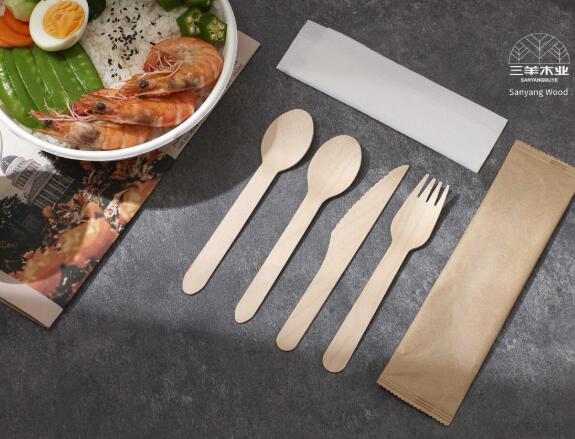

As the world takes a collective step toward sustainable living, disposable wooden cutlery has emerged as a popular eco-friendly alternative to plastic. Its biodegradable nature and minimal environmental impact make it a natural choice for eco-conscious consumers and businesses alike. However, while wooden cutlery may seem like a perfect solution to the single-use plastic problem, it’s not without its drawbacks.
In this blog, we’ll explore the lesser-known disadvantages of disposable wooden cutlery, addressing its challenges from both a consumer and business perspective. What’s more, we’ll provide solutions to overcome these limitations and shed light on how manufacturers, such as any disposable wooden cutlery factory, are playing a vital role in addressing these challenges.
Before diving into the drawbacks, it’s important to understand what disposable wooden cutlery is and why it’s gained such widespread appeal. Wooden cutlery is single-use utensils – forks, knives, spoons – made primarily from materials like birchwood, bamboo, or other types of hardwood. These utensils are valued for being:
Fully biodegradable and compostable.
An eco-friendly alternative to single-use plastics.
Suitable for all types of food, from casual meals at events to takeaways from restaurants.
They’ve become the go-to choice for businesses looking to reduce their environmental footprint and consumers demanding sustainable solutions. However, disposable wooden cutlery, like any product, has its limitations, which must be understood before making the switch.

One of the most significant drawbacks of disposable wooden cutlery is its relatively higher cost compared to plastic alternatives. Wooden cutlery requires higher-quality natural materials, sustainable sourcing limitations, and careful manufacturing practices.
The raw materials used in disposable wooden cutlery — such as birchwood or bamboo — are costlier than plastic, which is made from cheap petroleum-based resources.
Manufacturing in a disposable wooden cutlery factory often involves stringent quality control and eco-certification requirements, adding extra costs.
For small-scale businesses or food retailers working on tight profit margins, these higher costs may represent a barrier to adopting wooden cutlery.
While wooden cutlery is functional for most soft or moderately hard foods, it may face challenges when used with particularly hard or dense items, such as tough meats, frozen desserts, or large fruits.
Consumers may experience occasional splintering, bending, or breaking when applying excessive pressure, which can lead to frustrating experiences.
While bamboo cutlery (a specific type of wooden cutlery) offers greater strength, it comes at an even higher price, further complicating affordability issues.
Durability concerns may deter businesses in certain industries, such as large catering services, from choosing disposable wooden cutlery.
Some users report that disposable wooden cutlery leaves a slight “woody” or “earthy” aftertaste, particularly when paired with hot or liquid-heavy foods such as soups, sauces, or moist desserts. This is because the raw material (wood) naturally retains its flavors and scent even after production.
The rougher texture of wooden cutlery, compared to the smooth finish of plastic alternatives, may also feel uncomfortable to some consumers.
This tactile experience might discourage individuals from fully embracing wooden utensils, especially in high-end or premium dining settings.
While disposable wooden cutlery is marketed as environmentally friendly, there are concerns about its production when operating on a large scale.
If not properly managed, the production of wooden cutlery can contribute to deforestation, as factories require significant quantities of wood to meet high demand.
Not all manufacturers produce cutlery from sustainably sourced wood, raising questions about the authenticity of their "eco-friendly" claims.
To ensure true sustainability, businesses must carefully consider their sourcing and partner with certified sustainable disposable wooden cutlery factories that prioritize reforestation and responsible forestry practices.
Disposable wooden cutlery is often bulkier than plastic utensils, making them more difficult to transport and store in large quantities.
Wooden cutlery doesn’t stack as efficiently as plastic counterparts due to its shape, adding to storage needs for both businesses and manufacturers.
Transporting wooden cutlery in bulk can lead to higher logistics and delivery costs, particularly for smaller businesses.
Large-scale foodservice providers may face challenges managing these logistics without an optimized supply chain.
Factories producing disposable wooden cutlery face strict sustainability, health, and quality regulations.
Certification processes, compliance with food safety standards, and adherence to eco-friendly guidelines can drive up costs in a disposable wooden cutlery factory.
This can make it difficult for new manufacturers to enter the market or for smaller ones to remain competitive.
Given the disadvantages above, some businesses opt for other eco-friendly alternatives like:
Compostable plastics: These offer biodegradability and affordability but may not meet sustainability goals to the same degree as wooden cutlery.
Bamboo cutlery: Bamboo offers higher durability and strength but is often more expensive than regular wooden cutlery.
Understanding balance is key: businesses must assess their target audience, cost considerations, and environmental goals to choose the right alternative.
While wooden cutlery has its challenges, there are ways to minimize the drawbacks:
Reduce Costs Through Partnerships:
Partner with a trusted disposable wooden cutlery factory to buy in bulk and negotiate prices that align with your business model.
Use Sustainable Materials:
Source cutlery made from fast-growing woods or bamboo to ensure lower environmental impact without sacrificing durability.
Enhancements in Manufacturing:
Factories can invest in polished designs to eliminate splintering and minimize wood's aftertaste, improving the overall dining experience.
Educate Consumers:
Inform customers about the sustainability benefits of wooden cutlery to help offset any minor inconveniences like texture or cost.
Despite its disadvantages, wooden cutlery’s benefits — particularly its contribution to sustainability, waste reduction, and reduced plastic pollution — far outweigh its limitations. For eco-conscious businesses, these utensils provide an opportunity to align with consumer values and stand out as ethical, sustainable brands.
Disposable wooden cutlery may not be perfect, but it remains a strong contender in the battle against single-use plastics. While businesses and consumers may face challenges like higher costs, limited durability for certain foods, and occasional splintering, solutions exist to mitigate these concerns. By partnering with a reputable disposable wooden cutlery factory, sourcing sustainable materials, and improving manufacturing processes, businesses can embrace this eco-friendly alternative confidently.